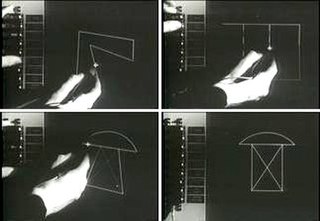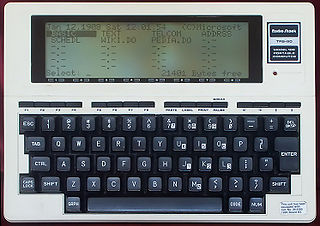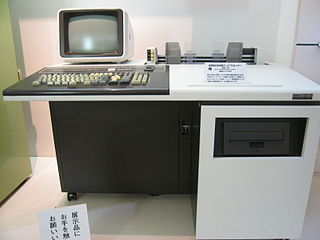Related Research Articles

The history of the graphical user interface, understood as the use of graphic icons and a pointing device to control a computer, covers a five-decade span of incremental refinements, built on some constant core principles. Several vendors have created their own windowing systems based on independent code, but with basic elements in common that define the WIMP "window, icon, menu and pointing device" paradigm.

The TRS-80 Micro Computer System is a desktop microcomputer launched in 1977 and sold by Tandy Corporation through their RadioShack stores. The name is an abbreviation of Tandy/RadioShack, Z80 microprocessor. It is one of the earliest mass-produced and mass-marketed retail home computers.

The RadioShack TRS-80 Color Computer is a line of home computers based on the Motorola 6809 processor. The Tandy Color Computer line started in 1980 with what is now called the CoCo 1 and ended in 1991 with the more powerful CoCo 3. All three CoCo models maintained a high level of software and hardware compatibility, with few programs written for the older model being unable to run on the newer ones.

WordStar is a word processor application that had a dominant market share during the early- to mid-1980s, succeeding the prior market leader Electric Pencil. It was published by MicroPro International, and written for the CP/M operating system but later ported to MS-DOS. Although Seymour I. Rubinstein was the principal owner of the company, Rob Barnaby was the sole author of the early versions of the program. Starting with WordStar 4.0, the program was built on new code written principally by Peter Mierau.

The Tandy 1000 was the first in a line of IBM PC compatible home computer systems produced by the Tandy Corporation for sale in its Radio Shack and Radio Shack Computer Center chains of stores.
IBM PC compatible computers are similar to the original IBM PC, XT, and AT that are able to use the same software and expansion cards. Such computers were referred to as PC clones, or IBM clones. The term "IBM PC compatible" is now a historical description only, since IBM no longer sells personal computers. The industry jargon "PC" sometimes doesn't mean "personal computer" generally, but rather a computer running Microsoft Windows, in contrast to Apple's Mac.

Desktop publishing (DTP) is the creation of documents using page layout software on a personal ("desktop") computer. It was first used almost exclusively for print publications, but now it also assists in the creation of various forms of online content. Desktop publishing software can generate layouts and produce typographic-quality text and images comparable to traditional typography and printing. Desktop publishing is also the main reference for digital typography. This technology allows individuals, businesses, and other organizations to self-publish a wide variety of content, from menus to magazines to books, without the expense of commercial printing.
Microsoft BASIC is the foundation software product of the Microsoft company. It first appeared in 1975 as Altair BASIC, which was the first version of BASIC published by Microsoft as well as the first high-level programming language available for the Altair 8800 microcomputer.

The Amstrad PCW series is a range of personal computers produced by British company Amstrad from 1985 to 1998, and also sold under licence in Europe as the "Joyce" by the German electronics company Schneider in the early years of the series' life. The PCW, short for Personal Computer Word-processor, was targeted at the wordprocessing and home office markets. When it was launched the cost of a PCW system was under 25% of the cost of almost all IBM-compatible PC systems in the UK, and as a result the machine was very popular both in the UK and in Europe, persuading many technophobes to venture into using computers. However the last two models, introduced in the mid-1990s, were commercial failures, being squeezed out of the market by the falling prices, greater capabilities and wider range of software for IBM-compatible PCs.
The Tandy 2000 is a personal computer introduced by Radio Shack in September 1983 based on the 8 MHz Intel 80186 microprocessor running MS-DOS. By comparison, the IBM PC XT used the older 4.77 MHz 8088 processor, and the IBM PC AT would later use the newer 6 MHz Intel 80286. Due to the 16-bit-wide data bus and more efficient instruction decoding of the 80186, the Tandy 2000 ran significantly faster than other PC compatibles, and slightly faster than the PC AT. The Tandy 2000 was the company's first computer built around an Intel x86 series microprocessor; previous models used the Z80 and 68000 CPUs.

Text-based user interfaces (TUI), alternately terminal user interfaces, to reflect a dependence upon the properties of computer terminals and not just text, is a retronym parallel to the concept of graphical user interfaces (GUI). Like GUIs, they may use the entire screen area and accept mouse and other inputs. They may also use color and often structure the display using special graphical characters such as ┌ and ╣, referred to in Unicode as the "box drawing" set. The modern context of use is usually a terminal emulator.

LocoScript is a word processing software package created by Locomotive Software and first released with the Amstrad PCW, a personal computer launched in 1985. Early versions of LocoScript were noted for combining a wide range of facilities with outstanding ease of use. This and the low price of the hardware made it one of the best-selling word processors of the late 1980s. Four major versions of LocoScript were published for the PCW, and two for IBM-compatible PCs running MS-DOS. LocoScript's market share didn't expand with the PC versions, which were not released until after Windows had become the dominant PC operating system.

DeskMate is a discontinued software application that provided an operating environment that competed with early versions of Microsoft Windows. It originally was made for Tandy's TRS-DOS Operating System and for their TRS-80 line of computers, but eventually shifted to PC, where it was developed using C and Assembly. Like Windows, it was not a full operating system, requiring a separate disk operating system in order to function. Although the initial PC ports would only run on Tandy's PCs, the introduction of the true PC-compatible computers such as the Tandy 3000 resulted in the software later being made available for other compatibles.

The TRS-80 Model 100 is a portable computer introduced in 1983. It is one of the first notebook-style computers, featuring a keyboard and liquid crystal display, in a battery-powered package roughly the size and shape of a notepad or large book.

The TRS-80 Model II was a computer system launched by Tandy in October 1979, and targeted at the small-business market.

Home computers were a class of microcomputers that entered the market in 1977 and became common during the 1980s. They were marketed to consumers as affordable and accessible computers that, for the first time, were intended for the use of a single nontechnical user. These computers were a distinct market segment that typically cost much less than business, scientific or engineering-oriented computers of the time such as the IBM PC, and were generally less powerful in terms of memory and expandability. However, a home computer often had better graphics and sound than contemporary business computers. Their most common uses were playing video games, but they were also regularly used for word processing, doing homework, and programming.

A command-line interface (CLI) processes commands to a computer program in the form of lines of text. The program which handles the interface is called a command-line interpreter or command-line processor. Operating systems implement a command-line interface in a shell for interactive access to operating system functions or services. Such access was primarily provided to users by computer terminals starting in the mid-1960s, and continued to be used throughout the 1970s and 1980s on VAX/VMS, Unix systems and personal computer systems including DOS, CP/M and Apple DOS.

A word processor (WP) is a device or computer program that provides for input, editing, formatting and output of text, often with some additional features.

The Olivetti M20 is a Zilog Z8000 based computer from Olivetti introduced in 1982. Although it offered good performance, it suffered from a lack of software due to its use of the Z8000 processor and custom operating system, PCOS. The company introduced an IBM PC compatible in January 1984 and the M20 line was phased out.
References
- ↑ "CORDIS Archive : ISTWeb | FP6 | Interface and Cognition | People". Cordis.europa.eu. 2010-02-03. Retrieved 2012-08-06.
- ↑ "Personal Computer World - index 1978-June 1989". Ukfree.tv. Retrieved 2012-08-06.
- ↑ "Peter's stuff". Vekinis.com. Retrieved 2012-08-06.